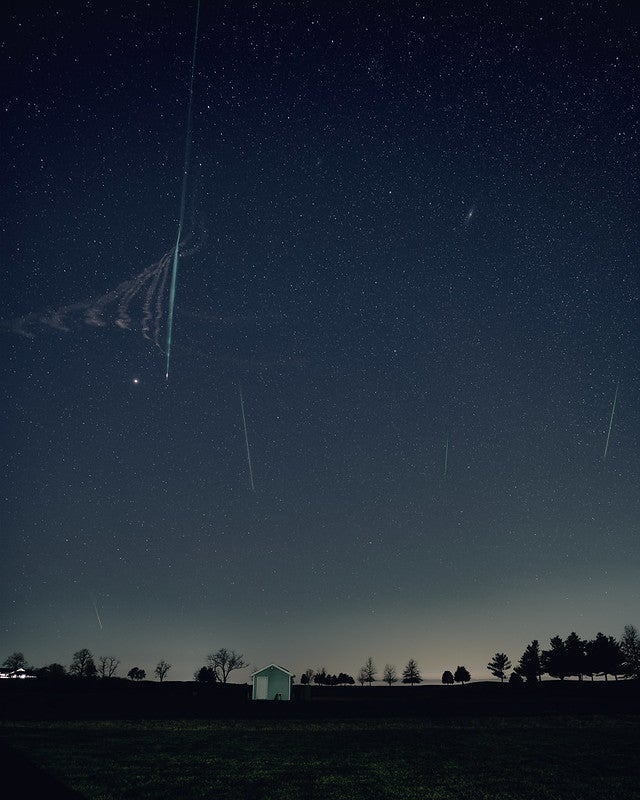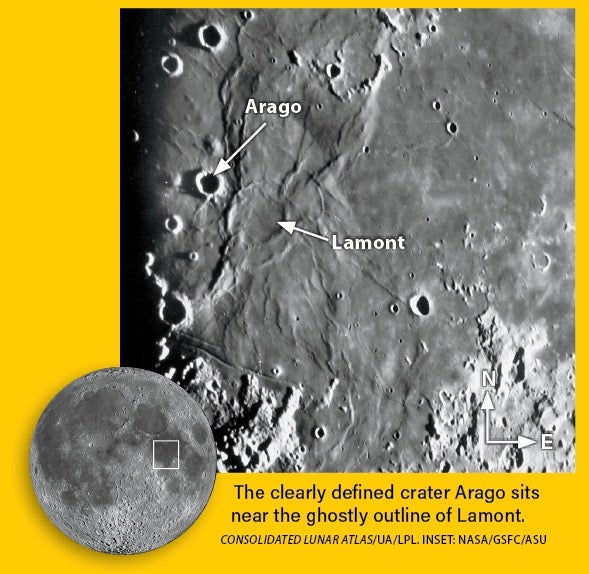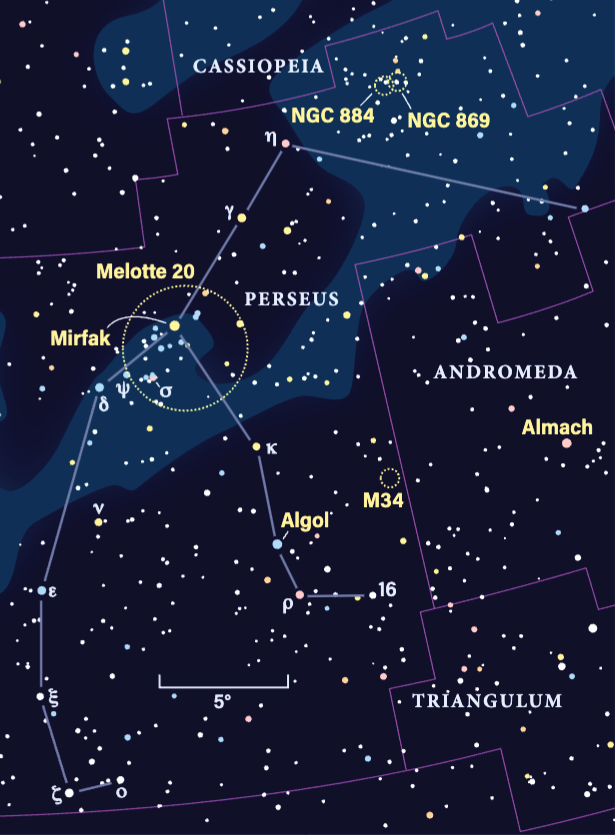
Friday, November 17
The Leonid meteor shower, which brings remnants of Comet 55P/Tempel-Tuttle streaking through our skies, peaks overnight tonight and early tomorrow morning. Shower meteors appear to originate from a point in the Sickle of Leo, which outlines the big cat’s head and forms a pattern of stars that looks like a backwards question mark. This region rises shortly before midnight, after the waxing crescent Moon has set. Step outside late and stay up into the early-morning hours of the 18th as Leo rises ever higher to view the most shower meteors. Late-night observers out before midnight should look east near Gemini, Orion, and Taurus — these constellations precede Leo through the sky and are likely to be where the most shower meteors are visible before the Lion rises.
The Leonids’ maximum rate is expected to reach around 10 meteors per hour, though this assumes the radiant is directly overhead at the zenith. Because that won’t be the case for observers while the sky is dark, you can expect slightly fewer meteors, but still a noticeable bump from the 2 to 3 per hour of the sporadic background rate. Plus, meteor streams are unpredictable and small flurries of shooting stars can occur. Leonid meteors are also particularly fast-moving, shooting through the sky at some 43.5 miles (70 kilometers) per second, sometimes leaving long, bright trails that can persist for tens of minutes.
Sunrise: 6:47 A.M.
Sunset: 4:42 P.M.
Moonrise: 11:25 A.M.
Moonset: 8:24 P.M.
Moon Phase: Waxing crescent (21%)
*Times for sunrise, sunset, moonrise, and moonset are given in local time from 40° N 90° W. The Moon’s illumination is given at 12 P.M. local time from the same location.

Saturday, November 18
Mars is in conjunction with the Sun at 1 A.M. EST; the Red Planet will remain out of sight for the rest of the year.
Tonight, the waxing crescent Moon rises around noon and sets shortly before 10 P.M. local time. Before then, turn your telescope on Mare Tranquillitas, otherwise known as the Sea of Tranquillity, which contains the landing site for the famous Apollo 11 mission that first saw men walk on the Moon.
We’re looking for a buried, almost “ghostly” feature called Lamont, located in the western portion of Tranquillity. Researchers think this is the remnant of a long-ago impact basin that has since been flooded with lava, leaving only the very highest parts of the rim visible. All we can see today are concentric ridges that look almost like wrinkles in the flatter floor of the dark “sea.” Note in particular the small crater Arago to Lamont’s northwest — this impact came much later. To Arago’s immediate north is a strange “bump” in the landscape that betrays the presence of a volcanic dome.
The Moon’s features often seem to change day by day as the Sun moves in the lunar sky. Many of the subtler details visible in this region tonight will be nearly invisible by tomorrow if you return to look and compare, as the Sun will be higher overhead as lunar day makes its way across the nearside.
Sunrise: 6:48 A.M.
Sunset: 4:41 P.M.
Moonrise: 12:10 P.M.
Moonset: 9:39 P.M.
Moon Phase: Waxing crescent (31%)
Sunday, November 19
Early risers can catch a beautiful sight as bright Venus sits near the stunning double star Porrima in Virgo the Maiden this morning. The pair rise together around 3 A.M. local time and are more than 25° high 90 minutes before sunrise.
The two are just 2° apart, with Venus sitting directly below (southeast of) Porrima in the sky. Venus is much brighter — magnitude –4.3 — while Porrima appears as a single point of light shining a much fainter magnitude 2.7. Another 12.5° directly below Venus is Spica, Virgo’s brightest star at magnitude 1.
Pull out a telescope and check out Venus first. The planet spans some 19″ and is 63 percent lit, displaying a gibbous face. Next, drift upward to Porrima to observe its two components, nearly twin stars of similar brightness and color. They are both young stars some 1.4 times the mass of the Sun. The two stars are now roughly 3″ apart — quite close but resolvable in most scopes. The stars have a highly elliptical orbit that lasts nearly 170 years and their last close approach was in 2005. They are now growing farther apart. Careful observers can record their positions over the course of many years and notice a definite difference with time.
Sunrise: 6:49 A.M.
Sunset: 4:41 P.M.
Moonrise: 12:47 P.M.
Moonset: 10:54 P.M.
Moon Phase: Waxing crescent (42%)

Monday, November 20
First Quarter Moon occurs at 5:50 A.M. EST. A few hours later, the Moon passes 3° south of Saturn at 9 A.M. EST. Neither of these events are visible, but you can instead catch the pair in the south after sunset this evening, where they float together in sparse southern Aquarius.
By this evening, the Moon sits to the lower left of Saturn and the two are roughly 5.5° apart, though the distance will depend slightly on the time of night you look. Saturn, at magnitude 0.8, is not particularly faint, but still might be a bit hard to pick out by eye with the bright Moon so close by. You should be able to pick the planet up easily in binoculars or a telescope, though, and enjoy the one-of-a-kind ring system for which it’s so well known. Saturn’s rings currently stretch roughly 40″ across, just over twice as wide as the face of the planet itself. They’re tilted some 10° to our line of sight, showing off their northern face.
Several of the planet’s moons are clustered around it, though the fainter satellites might be more difficult to spot in the moonlight. Brightest is 8th-magnitude Titan, which lies just over 1.5′ west-southwest of the planet’s center tonight. Dimmer moons that may be visible in larger apertures or astrophotos include 10th-magnitude Tethys, Rhea, and Dione; the former lies just southwest of the planet’s limb, south of the rings, while Dione is close and slightly southwest and Rhea is farther and slightly northwest of the planet.
Dwarf planet 1 Ceres reaches conjunction with the Sun at 11 A.M. EST, rendering it invisible for now.
Sunrise: 6:51 A.M.
Sunset: 4:40 P.M.
Moonrise: 1:17 P.M.
Moonset: —
Moon Phase: Waxing gibbous (54%)
Tuesday, November 21
The Moon reaches perigee, the closest point to Earth in its orbit, at 4:01 P.M. EST. At that time, our satellite will sit 229,795 miles (369,819 km) away.
Jupiter’s moon Ganymede puts on a good show early this morning, with observers in the western half of the U.S. winning the lottery for the best views of the entire event. Let’s start in the Midwest around 4 A.M. CST, when Jupiter is just 12° high in the west. Through a telescope, you’ll see that Ganymede sits close to the planet’s northwestern limb. Meanwhile, Europa is visible alone to Jupiter’s east, while Io sits closet to the planet to the west, with Callisto farther out on the same side.
Around 4:10 A.M. CST, Ganymede finally begins to disappear, first blending with the limb before it winks out over the course of about 10 minutes. This can be a fascinating process to watch. Just over an hour later, at 5:30 A.M. CST — when Jupiter is very near the horizon in the Midwest — the moon reappears off the northeastern limb, having crossed behind the polar region.
But there’s a catch — Ganymede is only visible for another 24 minutes before it disappears again, this time into Jupiter’s long, dark shadow, which stretches out behind the planet. It takes another two hours for Ganymede to reappear this time, popping out from the darkness some 20″ from the planet’s limb around 5:37 A.M. PST. Note that by this time, Jupiter is quite low for even the West Coast, so observing Ganymede’s reappearance might be a challenge — but a rewarding one.
Sunrise: 6:52 A.M.
Sunset: 4:39 P.M.
Moonrise: 1:44 P.M.
Moonset: 12:09 A.M.
Moon Phase: Waxing gibbous (65%)
Wednesday, November 22
The Moon continues along the ecliptic, now passing 1.5° south of Neptune at 3 A.M. EST. Again, the pair isn’t visible at this time but instead can be seen in the evening sky after dark. An hour after sunset, Neptune is already 40° high, located right at the border between Pisces and Aquarius. The Moon has moved on somewhat, now roughly 9° east of the planet, which is actually a help if you want to locate the distant ice giant in your optics, as this bright source of light is at least a little farther from our target.
To find Neptune, first find the Circlet of Pisces, an asterism of seven stars in far western Pisces that forms a roughly oval shape. From magnitude 4.5 Lambda (λ) Piscium, the southeasternmost star in this pattern, drop 5° due south to land on the distant planet. Neptune, which glows a soft magnitude 7.7, is not visible to the naked eye even under dark conditions, so will need binoculars or a telescope to spot. It should appear as a slightly “flat” blue-gray star with a diameter of just 2″ — it won’t look quite pointlike, but more like a tiny disk.
Heading back up to the Circlet, you can also inspect one of its most unique stars: 19 Psc (also called TX Psc), the Circlet’s easternmost star. This 5th-magnitude sun appears a deep red color, thanks to plentiful carbon in its atmosphere. TX is also a variable star and contains technetium in its atmosphere — an element not naturally found on Earth, thanks to its short half-life.
Sunrise: 6:53 A.M.
Sunset: 4:39 P.M.
Moonrise: 2:08 P.M.
Moonset: 1:22 A.M.
Moon Phase: Waxing gibbous (75%)
Thursday, November 23
It’s not Thanksgiving without some turkey! Although there’s no official deep-sky object bearing this bird’s name, some observers like to imagine the famous Orion Nebula (M42) as the Great Turkey Nebula.
To see if you can spot this cosmic fowl, you’ll need to let Orion the Hunter rise above the horizon. Wait until at least 9 P.M. local time and you should spot the three stars that form the straight line of Orion’s Belt some 15° or higher in the east. Start at the lowest star — that’s magnitude 1.7 Alnitak — and look just over 3.5° south-southwest, or to its lower right. You may see it a fuzzy patch of light with the naked eye if you’re in a dark location: That’s the Orion Nebula. It can be easily seen with binoculars or any telescope as a gauzy, bright glow surrounding several tightly packed bright stars — these are the Trapezium Cluster, birthed from the clouds of gas and dust that make up the nebula. These massive suns are now starting to sculpt the clouds with the intense winds they blast out.
Take some time to study the nebula and its shape. Does it look like a Turkey to you? The “head” is a hooked cloud along the northern edge, with the large, round body and fanned-out tail extending to the south. If you can’t see enough detail at the eyepiece, consider taking a photograph, which will gather more light than your eye is capable of bringing in to better highlight the clouds’ shape more sharply. And even if you don’t see the Great Turkey Nebula, M42 is still one of the very best deep-sky sights you can catch to top off an excellent evening of family and feasting.
Sunrise: 6:54 A.M.
Sunset: 4:38 P.M.
Moonrise: 2:31 P.M.
Moonset: 2:33 A.M.
Moon Phase: Waxing gibbous (84%)

Friday, November 24
Let’s cap off the week with a famously “demonic” star. Algol in Perseus is the constellation’s 2nd-magnitude beta star; it’s a well-known variable with a companion that crosses in front of it every 2.87 days like clockwork. When this occurs, Algol fades from its usual magnitude of 2.1 down to magnitude 3.4 for just 10 hours at a time before brightening to normal again.
Tonight is an opportunity to catch Algol at that minimum, which it reaches at 2:44 P.M. EST and lasts for the aforementioned 10 hours. So, Algol should appear at its faintest for most of the evening, before slowly starting to brighten again in the early-morning hours of the 25th.
To find Algol, look high in the east after dark, where Perseus lies just to the upper left of the V-shaped face of Taurus the Bull and the bright cluster of stars known as the Pleiades. Once you find Algol, it will look like a single point of light in binoculars or telescopes — its companion is too faint to see, so the second star’s presence is only obvious when it passes in front of the visible component and dims it.
The best way to compare Algol at its faintest and brightest is to look at the stars around it — particularly Mirfak, also cataloged as Alpha (α) Persei. (Check out our star chart for help identifying it.) When it’s shining normally (i.e., brightest), Algol’s magnitude roughly matches that of Mirfak. But when it’s eclipsed, as it is tonight, Algol is notably fainter. Can you see the difference between the two stars tonight? Come back tomorrow and compare again. They should appear much closer in brightness!
Perseus contains several other cosmic wonders worth a look — check out Astronomy contributing author Phil Harrington’s November column to more fully explore the constellation Perseus.
Sunrise: 6:55 A.M.
Sunset: 4:38 P.M.
Moonrise: 2:57 P.M.
Moonset: 3:46 A.M.
Moon Phase: Waxing gibbous (92%)

Sky This Week is brought to you in part by Celestron.









